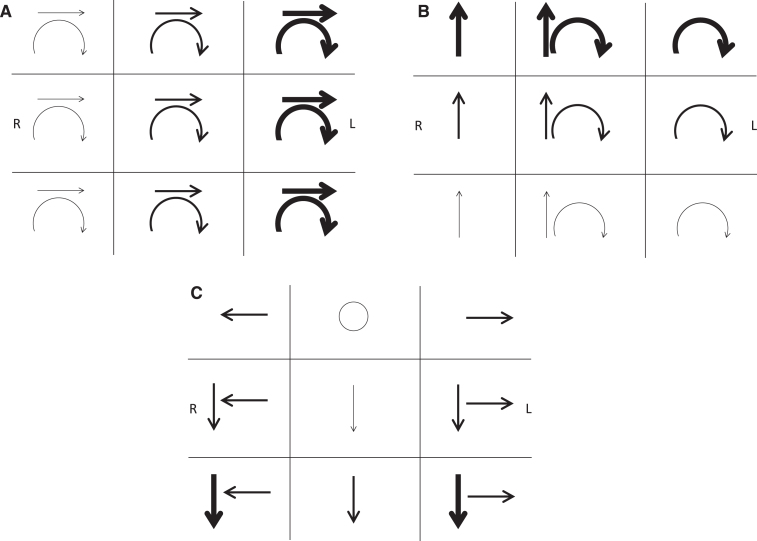Fig.1.
Jerk nystagmus schematic notation. Representing the important attributes of three-dimensional eye movements on a two-dimensional page presents several challenges requiring care to avoid ambiguity. As with describing nystagmus, its schematic notation should document the direction and intensity in the 9 cardinal gaze positions. If the nystagmus is not conjugate, each eye’s characteristics can be documented separately. By convention, eye movements are drawn from the vantage point of the examiner in front of the patient. Text should indicate whether arrows represent the slow or fast phase direction. In A-C, the arrows denote the direction of the fast phases, with the boldness of the arrows reflecting the intensity of the nystagmus. The frame of reference must be specified in every schematic in order to clarify whether the arrows for a given gaze position refer to eye movements being described in head-fixed coordinates (as viewed face to face with the patient) or eye-fixed coordinates (as viewed along the patient’s visual axis). The frame of reference that most efficiently describes a given pathologic nystagmus is typically the one most closely linked to the mechanism or site causing the nystagmus. Examples are shown: (A) Spontaneous third-degree horizontal-torsional left-beating peripheral vestibular nystagmus. This mixed horizontal-torsional nystagmus in straight-ahead gaze that obeys Alexander’s law (increases when looking in the fast phase direction and decreases when looking in the slow phase direction) is typical for an uncompensated right unilateral vestibular lesion. In this case the nystagmus directional arrows are in head-referenced coordinates, reflecting the combined effect of injury to all three semicircular canals and producing nystagmus that remains in a fixed direction with respect to the head and labyrinths regardless of gaze position (see Fig. 3). (B) Left posterior semicircular canal benign paroxysmal positional nystagmus. Nystagmus elicited in the left Dix-Hallpike position consists of mixed upbeat and torsional nystagmus with the upper pole of the eyes beating toward the left ear in straight-ahead gaze. Since the nystagmus direction is fixed in the plane of the left posterior canal, it appears predominantly vertical in rightward gaze and predominantly torsional in leftward gaze when observed along the patient’s visual axis (as documented in each box representing eye-referenced coordinates in this schematic), as well as obeying Alexander’s law. Note that the torsional fast phases could be confusingly described as clockwise from the examiner’s perspective (incorrect, but commonly used) but counterclockwise from the patient’s perspective (correct, but inconsistently used). (C) Spontaneous downbeat and bilateral gaze-holding nystagmus. Low-intensity pure downbeat nystagmus in straight-ahead gaze increases in lateral and downgaze and is associated with pathologic bilateral gaze-holding nystagmus. This schematic uses head-referenced coordinates, indicating that the downbeat component appears to remain fixed to labyrinthine coordinates regardless of gaze position. This may imply that the downbeat nystagmus is coming from a vestibular tone imbalance of the vertical rotational vestibulo-ocular reflex.

